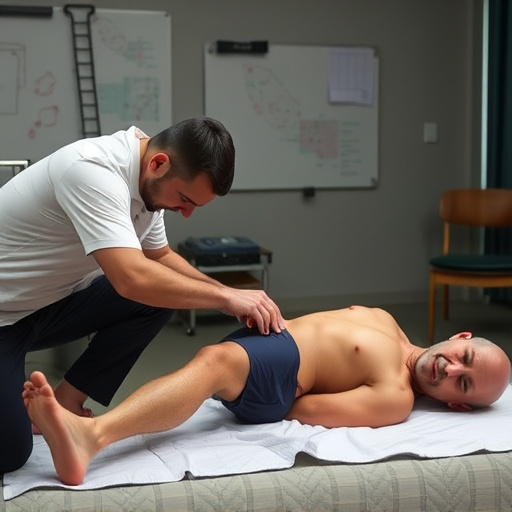Occupational injury treatment transcends initial wound care, emphasizing holistic rehabilitation and prevention for long-term health. Integrating chiropathic care, physical therapy, ergonomic assessments, and counseling aims to restore function, reduce pain, and educate workers on injury prevention. Early intervention, comprehensive approaches, and innovative therapies like shockwave treatment improve outcomes, enhance satisfaction, and accelerate returns to work, promoting sustained well-being in professional lives.
Occupational injury treatment goes beyond immediate care, serving as a cornerstone for long-term health. This comprehensive approach not only aids in recovery but also focuses on preventing future injuries and enhancing overall well-being. In this article, we explore three key dimensions: understanding the foundational role of occupational injury treatment, investigating the profound impact of early intervention, and delving into holistic rehabilitation and preventive measures that promote sustained longevity. Discover how these strategies interplay to optimize worker health over time.
- Understanding Occupational Injury Treatment: A Foundation for Longevity
- The Impact of Early Intervention on Long-Term Health Outcomes
- Holistic Approaches: Rehabilitation and Preventive Measures for Sustained Well-being
Understanding Occupational Injury Treatment: A Foundation for Longevity

Occupational injury treatment is not just about healing immediate wounds; it’s a cornerstone for fostering long-term health and longevity. This holistic approach recognizes that work-related injuries often lead to chronic conditions if left unaddressed, such as persistent neck pain or joint pain relief becoming long-lasting issues. Therefore, effective occupational injury treatment focuses on rehabilitation and prevention. Chiropathic care, for instance, is a common method used to treat neck pain, offering adjustments and exercises that promote healing while also teaching patients how to maintain their bodies’ alignment in the workplace.
By integrating various treatments tailored to individual needs—including physical therapy, ergonomic assessments, and counseling on injury prevention—occupational injury treatment seeks to restore function, reduce pain, and empower workers with knowledge. This not only facilitates a smoother return to work but also significantly lowers the risk of recurring injuries. In essence, occupational injury treatment isn’t just about fixing what’s broken; it’s about building resilience, ensuring sustained well-being, and enabling individuals to thrive in their professional lives without compromising their long-term health.
The Impact of Early Intervention on Long-Term Health Outcomes
Early intervention plays a pivotal role in shaping long-term health outcomes following an occupational injury. When treatment commences promptly after the incident, it can significantly reduce the risk of chronic pain and disability. Occupational injury treatment focuses on not just treating the immediate symptoms but also addressing the underlying causes to prevent future exacerbations. This proactive approach is particularly crucial for work-related injuries, as early management can help individuals return to their jobs faster and maintain long-term employability.
One effective method gaining traction in sports injury recovery and occupational injury treatment is shockwave therapy. This non-invasive procedure has shown promise in reducing pain and promoting healing in various conditions. By using focused acoustic waves, shockwave therapy for pain can stimulate tissue regeneration, enhance blood flow, and break up scar tissues, all of which contribute to improved functional outcomes. Integrating such innovative techniques into occupational injury treatment plans can lead to better patient satisfaction and more favorable health results over time.
Holistic Approaches: Rehabilitation and Preventive Measures for Sustained Well-being
Occupational injury treatment goes beyond addressing immediate medical needs; it embraces holistic approaches to rehabilitation and preventive measures that are crucial for sustained well-being. These strategies focus on restoring physical function, managing pain like sciatica relief, and preventing future injuries. For instance, following an auto accident recovery, a comprehensive plan might include physical therapy, ergonomic assessments, and education on injury prevention techniques.
By integrating these practices, individuals can achieve long-term health benefits that extend beyond the resolution of acute issues such as neck pain treatment. Holistic approaches empower workers to understand their bodies’ needs, adopt healthier habits, and develop resilience against future occupational hazards.
Occupational injury treatment, by focusing on early intervention, holistic rehabilitation, and preventive measures, plays a pivotal role in fostering long-term health. Understanding these foundational elements empowers individuals and organizations to navigate workplace challenges effectively, ensuring sustained well-being and productivity. Through comprehensive care, we not only treat injuries but also cultivate resilient and healthy work environments.














